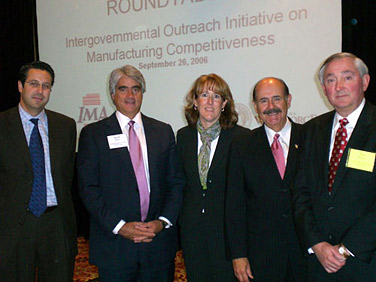|
|
|
|||||||||
|
Commerce Department and Indiana Join Together in Manufacturing Summit A summit with Indiana officials in September shows how cooperation with state governments is a key strategy in promoting a healthy manufacturing sector. by Matt Braud Officials from the state of Indiana and the U.S. Department of Commerce met in Indianapolis on September 26, 2006, to participate in the first-ever intergovernmental manufacturing summit. The Commerce Department’s Office of Manufacturing and Services hosted the event along with the Indiana Economic Development Corporation, the Indiana Manufacturers Association, the Central Indiana Corporate Partnership, and the Indiana Department of Workforce Development. (Story continues below.)
Follow-Up to 2004 Recommendations The primary purpose of the summit was to work with Indiana’s leaders to address manufacturing competitiveness in the state. But with this year’s summit, the Office of Manufacturing and Services took one step closer to implementing the remaining recommendations made in the Bush administration’s 2004 report on manufacturing competitiveness, Manufacturing in America. One of those recommendations called for the Commerce Department to “foster coordination and cooperation among the federal, state, and local governments.” Manufacturing in America included an in-depth analysis of trends affecting U.S. manufacturers and set forth, in 57 recommendations, a comprehensive strategy to address the challenges it identified. Those recommendations were based on a series of 23 manufacturing roundtables held across the country in 2003. Most of the roundtables were industry specific and included the participation of a wide range of small, medium-sized, and large companies. Since being established in 2004, the Office of Manufacturing and Services has worked to implement 35 of the 57 recommendations. Indiana’s Business Support Network Indiana was selected as the site of the manufacturing summit because of the support manufacturers have received there from leaders in government, business, and academia. After participating in Purdue University’s Advanced Manufacturing Summit in May 2006 (see the June 2006 issue of International Trade Update), Al Frink, assistant secretary of commerce for manufacturing and services, was impressed with the working relationships that were already in place. “I noticed how every stakeholder works together,” said Frink. “Their goals, objectives, and strategies are all unified to grow their manufacturing economy.” Indiana has a strong manufacturing sector. According to the Commerce Department’s Bureau of Economic Analysis, the state currently has the highest manufacturing gross state product, at 28.3 percent. Its leaders have been able to attract good-paying jobs and foreign investment by lowering taxes and ensuring a low cost of doing business. Indiana also has a world-class education system that emphasizes research, emerging technologies, and engineering. Economic development efforts by Indiana have proven successful. In 2006, the Indiana Economic Development Corporation surpassed previous job-creation levels and capital investment commitments, with competitive commitments for 15,722 new jobs (at an average hourly wage of $20.77) and $3.9 billion in private capital investment. Roundtable Exchanges Highlight the Summit The Indianapolis summit attracted representatives from government, economic development agencies, and a wide range of manufacturing industries. They participated in three roundtables that focused on the different challenges manufacturers face. The topics included manufacturing competitiveness, workforce development, and technology transfer. Follow-up discussions were productive and addressed many of the specific issues faced today by Indiana. The Office of Manufacturing and Services has worked closely with the Indiana Economic Development Corporation and the Central Indiana Corporate Partnership to build a stronger bridge between Washington, D.C, and Indiana. Jamie Estrada, deputy assistant secretary for manufacturing, noted, “The diverse group of participants underscored Indiana’s commitment to manufacturing competitiveness.” Public Education and Workforce Issues Are Key One strategy discussed at the summit was improving the public perception of manufacturing, to encourage future generations to consider a career in the field. Several of the summit participants pointed out that the “dirty smokestack” image of the manufacturing sector is outdated. Many of today’s manufacturing industries are in technologically advanced fields that provide excellent employment and advancement prospects, paying higher wages than other sectors. Because so many of today’s manufacturing jobs require advanced technical skills, summit participants agreed that the value of a technical education needs to be promoted to the public at large. The representatives from the Commerce Department pledged to work with their counterparts in other federal agencies to stress the importance of math and science education in primary, secondary, and technical schools. Positive Outcomes Foreseen Following the summit, Michael Maurer, Indiana’s secretary of commerce, was optimistic about his state’s manufacturing economy. “With the right policies on workforce, innovation, and business climate, manufacturing can continue to grow and create new jobs for Hoosiers,” Maurer said. According to Estrada, “The manufacturing summit was a success. Working with our partners outside of the [Washington] Beltway enabled us to gain valuable insight, which will benefit our role in the federal government.” Matt Braud is a public affairs specialist in the International Trade Administration’s Office of Public Affairs.
|
|
